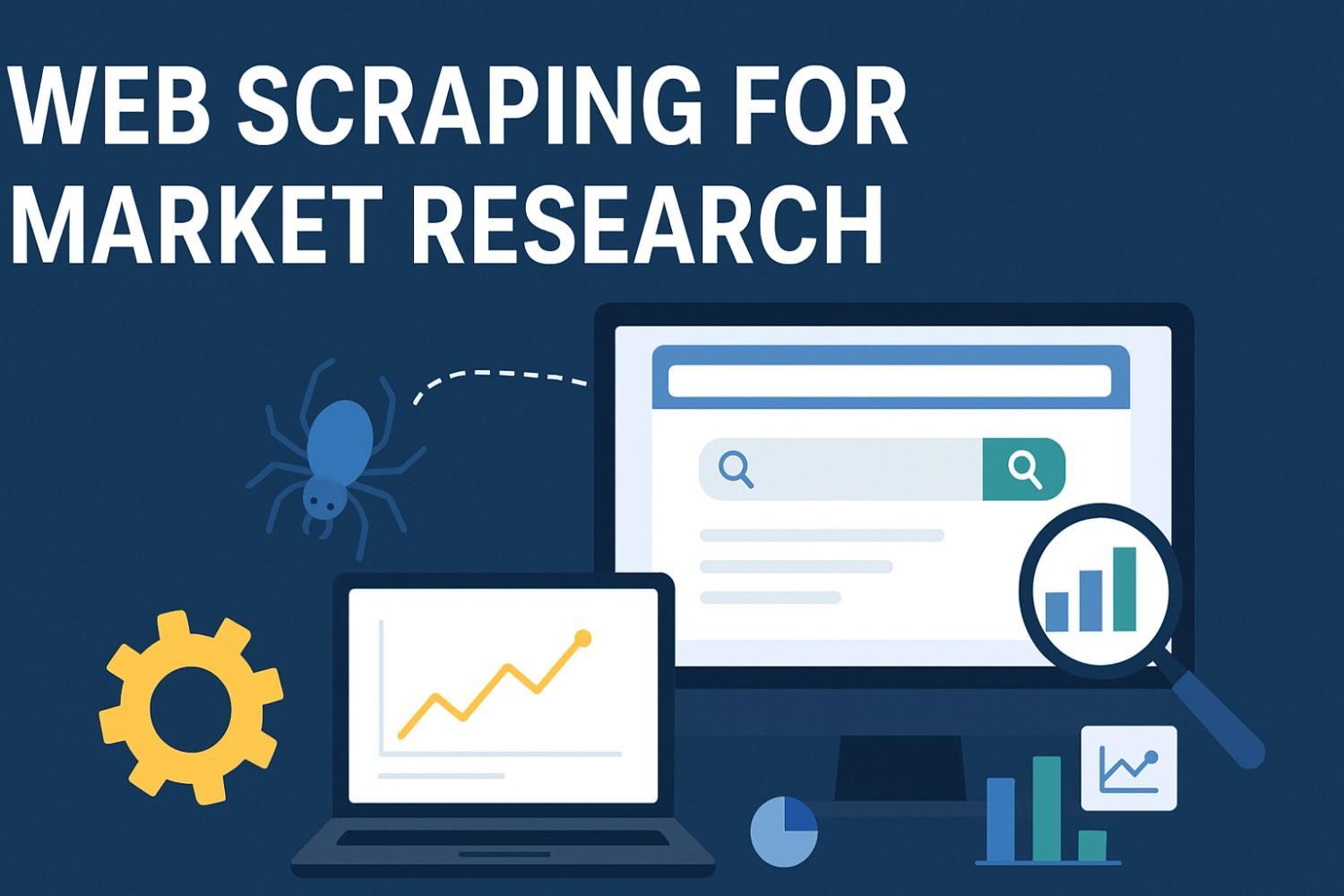Web Scraping for Market Research: The Shortcut to Smarter Strategy

Welcome to our little deep-dive (yes, we at KanhaSoft like “little” in the ironic sense) into how web scraping for market research really can function as your shortcut to a smarter strategy. Because let’s face it: in today’s digital world, if you’re not gathering data faster than your competitor, you’re already a few steps behind. And we don’t like being behind. (We’re more of a “ahead, ready, go” kind of company.)
We’ll walk you through what web scraping for market research means, why it matters, how to do it (without breaking the internet or your budget), what tools to use, how to pick web scraping services, and yes—how to avoid the “oops we got banned by that website” panic. We’ll throw in a personal anecdote too (because we like to keep it real) and we’ll end with FAQs—you know the drill.
Web Scraping for Market Research
When we say “web scraping for market research”, we’re talking about the process of automatically extracting large volumes of public data from websites (prices, product descriptions, review counts, competitive offers, sentiment, you name it) so you can feed that data into your strategy for market positioning, trend spotting, competitor watches, even launching new products. It’s not magic—but when done right, it feels like magic.
Why this matters: In the old days you’d send interns to manually copy-paste competitor prices into spreadsheets (yes—really). Now, with web scraping tools and services, you can watch entire markets shift in near-real time. And if your strategic planning cycle is still “once every quarter”, you’re missing the wave.
We at KanhaSoft know that when you launch a product, scale a business, or pivot in response to market changes, data is your lifeline. Without it you’re flying blind. With it—well, you at least have a compass (and if we provide a map too, all the better). So yes—the shortcut to smarter strategy is built on automated data pipelines, savvy analysis, and quick insights.
Why Market Research Needs Web Scraping
Market research traditionally involves surveys, focus groups, reports, maybe some analyst data. All fine—but slow, laborious, expensive. By contrast, web scraping gives you live signals: what customers are saying, how competitors are changing price, how demand fluctuates, how sentiment moves across reviews and forums.
For example: we once helped a client in the Middle East track 20+ competitor product pages across the US and UAE markets. Every morning they got a snapshot: “Price dropped 3% at Competitor A, review sentiment for Competitor B dropped by 12%.” They reacted that day. Whereas without scraping they'd have noticed next month. That’s the difference between “yawn, market change” and “aha, market move”.
Of course (and we’ll get into this), scraping doesn’t replace good analysis or human judgment. But it opens the door to much quicker reaction times. Because when you can spot the micro-trends (a product variant becoming popular, a review trend shifting, a competitor quietly reducing margin) you can adjust your strategy accordingly.
What You Can Extract (and Why It Matters)
Here’s a quick list of what web scraping can give you—and how it supports strategy. We like lists because they keep things tidy.
| Data Type | Strategic Value |
|---|---|
| Pricing & Promotions from competitors | Know when margin is under threat, when to match or differentiate |
| Product-feature changes | Spot product innovation, benchmark your offering |
| Customer reviews & ratings | Understand sentiment, emerging pain points, feature demand |
| Inventory / availability / out-of-stock signals | Gauge demand, anticipate supply issues, spot logistical opportunities |
| Trends across social or forum mentions | Find early signals of interest or discontent |
| Metadata (tags, categories, keywords) | Optimize your SEO, product taxonomy, discover market segments |
We used this kind of pipeline for one retail-tech client: weekly scrape, then daily alert if any competitor dropped price by more than 5%. They regained margin within 2 weeks. It’s not rocket science—it’s just acting faster.
How to Choose Web Scraping Services
If you’re not going to build scraping in-house (and many companies don’t, because it takes time and maintenance), you’ll contract one of the many web scraping companies USA or global that specialize in data extraction services. (Yes—we use the term “web scraping ” in one of our strategic documents, so we’ll weave it in.)
Here are the questions we always ask when choosing a scraping partner:
-
Do they handle proxies / IP-rotation / CAPTCHAs? Because you’ll hit blocking otherwise.
-
Do they support the sites you care about (region-specific: USA, UK, Israel, Switzerland, UAE)?
-
What format do they deliver data in? Clean CSV / JSON / database?
-
Are they compliant with legal-etiquette (robots.txt, terms of service) or at least managing risk?
-
How often can they scrape? Real-time, hourly, daily?
-
What support do they provide—data cleaning, feature extraction, analysis, not just “here’s raw dump”?
We worked with a partner whose contract said “we’ll provide raw data”—which was fine, until we realised we still spent 30% of our time cleaning and shaping that data. So our advice: pick someone who goes beyond the dump.
Web Scraping Tools (Build-Or-Buy)
If you prefer building the capability in-house (perhaps you have dev resources, or you want full control), then you’ll evaluate web scraping tools. Here’s what we at KanhaSoft typically recommend:
-
Python-based frameworks (BeautifulSoup, Scrapy) for flexible control, but you’ll need dev time and operational maintenance.
-
Cloud-based scraping platforms (e.g., Apify, Octoparse) where you pay for usage but get less overhead.
-
Hybrid: build some core extraction logic in-house, but use external tools for heavy lifting (IP proxies, CAPTCHA solving).
-
Ensure data pipeline: scraping → cleaning → storage → analytics. A tool is only useful if the end-to-end path works.
We once built a custom Web scraping tool for a SaaS client—they wanted to monitor how multiple marketplaces (USA and UAE) listed and described their product lines by region. We launched the bot, forgot to check site-structure changes, and after two weeks it broke silently. (Oops.) Lesson: maintenance matters.
Legal & Ethical Considerations
Because yes—it’s tempting to ignore this part, but we don’t. At KanhaSoft we always stress: web scraping for market research must be done with an eye on legality and ethics. Sites might have terms forbidding scraping, you might hit rate limits, you may access personal data which triggers privacy laws.
-
Check the website’s terms of service and robots.txt file.
-
Avoid scraping personal-identifiable information unless you are certain of legal compliance (GDPR, CCPA, etc.).
-
Use respectful request rates. Don’t hammer the server.
-
Consider using APIs if available (which some companies provide) rather than scraping the HTML.
-
Be transparent about your data usage internally—compliance is not just a check-box, it’s smart risk-management.
In one funny anecdote (yes—another one): we had a bot that scraped product listings overnight. One morning the CEO of the client asked “why are there 10,000 requests to that site at 3 am?” We had to explain (she blinked). Our bot was polite, queued requests, but the site infrastructure interpreted it as… well, suspicion. We adjusted the schedule. Moral: even bots need manners.
Using the Data: From Extraction to Insight
Scraping data is the easy part (relatively speaking). The harder—and far more strategic—part is turning that data into actionable insight. Here’s how we approach it:
-
Data cleaning & normalization: product names vary slightly, price formats differ, currencies differ. You need a clean base.
-
Feature extraction: categorize products, capture sentiment from review text, tag features mentioned, etc.
-
Visualization & alerts: set up dashboards or alerting when key triggers happen (price drops, review sentiment turns negative).
-
Strategic decision paths: the insight needs to feed back into business units (pricing, product, marketing).
-
Iteration: you’ll refine what to track. Maybe you start with price and reviews; later you add competitor features or stock availability.
At KanhaSoft we built a “market-pulse” dashboard for a retail client. Every Monday morning the team received an email summarizing: “Competitor X cut price, product Y sentiment dropped; consider promotion on your variant Z.” They used that to trigger meetings, not just reactively but proactively. That’s where the real value lies.
Use Cases Across Regions: USA, UK, Israel, Switzerland, UAE
Because we work across global markets, we often see how web scraping for market research must adapt regionally. Let’s compare:
-
USA & UK: mature e-commerce, many competitor price monitoring tools already exist; advantage is speed and depth of data.
-
Israel / Switzerland: might involve multi-language scraping (Hebrew/German/French), smaller sample sizes, niche markets—so every data point counts.
-
UAE / Middle East: rapidly evolving online retail, less transparent data, new marketplaces popping up; monitoring competitor behaviour early gives you the edge.
We had a client launching in UAE from Europe. They used web scraping tools to monitor local e-commerce listings and found a niche product variant wasn’t listed by any major competitor—but had growing mentions on social media. That early insight became their launch focus.
So whichever region you operate in—smart strategy demands localized, timely data. Web scraping enables that.
Common Pitfalls and How to Avoid Them
In our work at KanhaSoft we’ve seen clients stumble on some predictable mistakes. Let’s call them what they are—pitfalls—and then show how to sidestep them.
-
Data overload: You scrape everything and then get lost in the noise.
Fix: Start with key metrics (price, rating, stock), then expand. -
Ignoring maintenance: Websites change layouts, bots break.
Fix: Schedule periodic checks, alerts for failures, assign ownership. -
Focusing on scraping only: The tools are cool, but if you don’t integrate insight into decision-making, it’s wasted.
Fix: Define decision paths and KPIs in advance. -
Cost vs value mismatch: Some services scrape tons of data but you’re not using it.
Fix: Align cost with actionable use cases; pick the right web scraping services (not just lowest price). -
Ethics & legality slip-ups: Ignored terms, blocked IPs, potential legal exposure.
Fix: Involve legal/compliance early, respect rules and rate-limits.
We once met a client who had spent a lot on Web scraping tools but ended up with files of data in their inbox that no one opened. We told them: “Your real competition isn’t just gathering data—it’s acting on it.” They laughed—but changed their process.
DIY vs Full-Service: What’s Right for You?
Here’s a quick comparison to help decide whether you want to build in-house with web scraping tools or engage a full-service provider (one of the web scraping companies USA or global) like the ones we work with.
| Option | Pros | Cons |
|---|---|---|
| Build in-house (tools) | Full control, potentially lower ongoing cost, custom to your needs | Needs dev/ops resources, higher upfront cost, ongoing maintenance burden |
| Use full-service partner | Rapid setup, external expertise, fewer ops overhead | Potentially higher cost, less customization, maybe vendor lock-in |
At KanhaSoft we often recommend starting with a partner if you’re new to scraping and want quick wins—then gradually build internal capabilities. That gives you speed and learning curve.
How KanhaSoft Approaches Web Scraping for Market Research
Since we’re writing this as “we” (yes, our preferred pronoun at KanhaSoft), here’s how we do it:
-
Discovery session: We sit with you (virtually or in person) and map your key questions: What market? What competitors? What signals (price, sentiment, features)?
-
Design the extraction pipeline: Choose sites, regions (USA, UK, Israel, Switzerland, UAE), frequency, deliverables.
-
Build or integrate scraping infrastructure: We either plug your team into web scraping tools or we provide service.
-
Data cleaning & transformation: We handle raw data → structured data.
-
Dashboard & alerting setup: So you don’t log into spreadsheets—you get email/Slack alerts when something matters.
-
Decision-flow integration: We help you embed the insight into your strategy meetings, product roadmap, marketing plans.
-
Ongoing support & refinement: Sites change, you expand markets or metrics—we keep everything moving.
We’ve done this for clients—small, medium and enterprise—and we’ve seen a consistent result: faster reaction time, smarter product decisions, better competitive positioning. It’s not simple—but it is manageable. And yes, it’s a bit fun (we like data).
Best Practices for Starting Now
If you’re convinced (and we hope you are) here are actionable next steps:
-
Define one or two key questions you want answered (e.g., “Are our competitor prices dropping?” or “Are reviews complaining about battery life?”)
-
Select one region/market to start (don’t try five markets immediately)
-
Choose either a known scraping service or a tool you can control
-
Set frequency (daily is ideal, but weekly can work)
-
Build alert logic: when something changes > threshold > notify team
-
Assign a responsible owner inside your company (even if small) to review and act
-
Review results and refine every quarter
Start small, iterate, scale. Because the risk is not starting; the risk is doing a messy job and assuming “we’ll fix later” (spoiler: you probably won’t fix later).
Final Thought
At KanhaSoft we like to say: Data without action is just noise. Web scraping for market research isn't a silver bullet—but it is one of the sharpest tools you can add to your strategy toolbox. When you move from manual, lagging research to near-real-time insight, you gain a window into what the market is doing rather than what it was doing. That shift—from retroactive to proactive—is the real “shortcut” to smarter strategy.
So: if you’re ready to stop chasing competitors and start anticipating them—if you’re ready to turn public web data into strategic advantage—then let’s get scraping. Because in the race of markets, the early bots win.
Until next time — may your data streams stay clean, your insights stay sharp, and your strategy stay one step ahead.
FAQs
What exactly are Web Scraping Services?
Web scraping services are external providers (or internal teams) that extract structured data from websites automatically, on your behalf. They manage the technical details (IP rotation, CAPTCHA mitigation, scheduling) so you receive clean data you can act on.
How do I pick between web scraping tools and hiring a service?
Tools give you control and potentially lower cost if you have dev resources; services give you speed and expertise. If you’re starting out, go with a service; once you’re confident you may build your own tools.
Are there good web scraping companies USA I can work with?
Yes—there are many US-based and global firms with expertise in public data extraction. When you evaluate them, check their transparency, delivery format, region coverage (USA, UK, Israel, UAE etc), pricing and legal compliance.
Which Web Scraping Tools are most effective for market research?
Popular tools include open-source frameworks like Scrapy or BeautifulSoup (Python), cloud platforms like Apify or Octoparse, and commercial APIs. Choose one based on your skillset, budget, and volume of data required.
Is web scraping legal and ethical?
In most cases yes—if you are extracting publicly available data, respecting site terms of service, not gathering personal private data, and operating with reasonable request rates. But you must check each site, each jurisdiction. It's better to be safe than sorry.
How quickly can I get actionable insights after starting web scraping?
If set up correctly, you can start seeing insights within days—maybe weeks. The real value comes when you have reliable pipelines and alerts flowing into your decision-making. The “shortcut” part kicks in when you act faster than others.
What are typical costs for web scraping for market research?
Costs vary widely depending on scale (number of sites, frequency, data volume, regions). For some clients we’ve seen monthly budgets starting modestly and scaling as the program proves its value. Always tie cost to your potential benefit (price loss avoided, product launch improved, etc).






